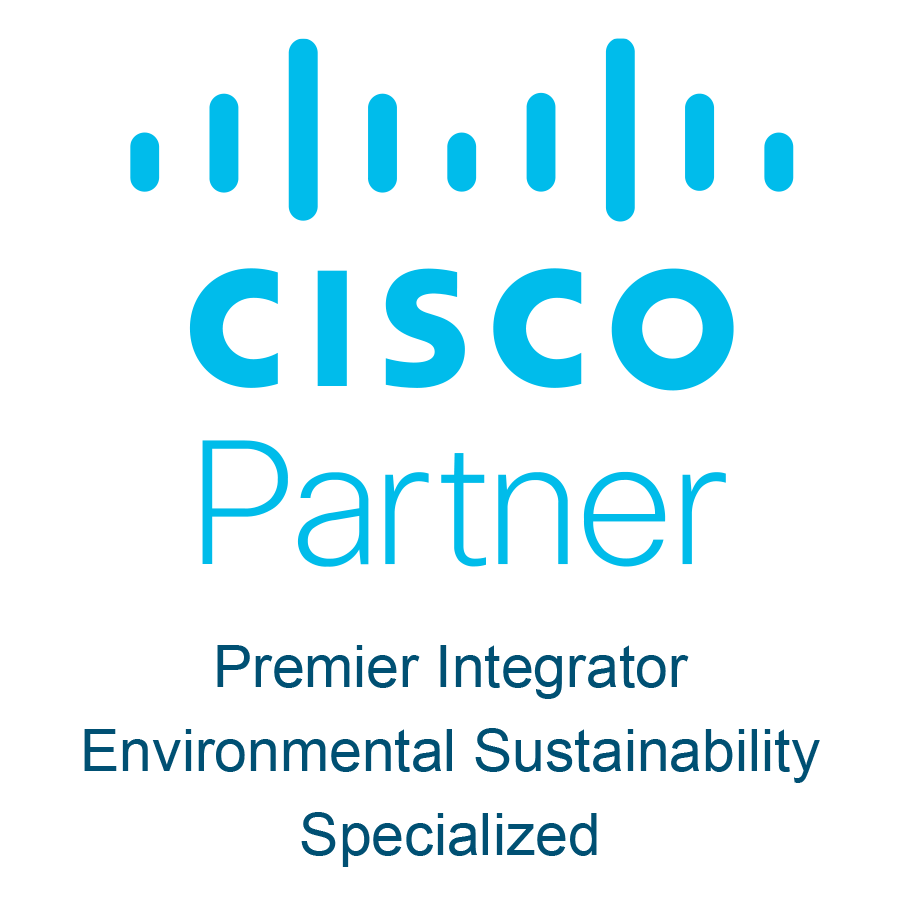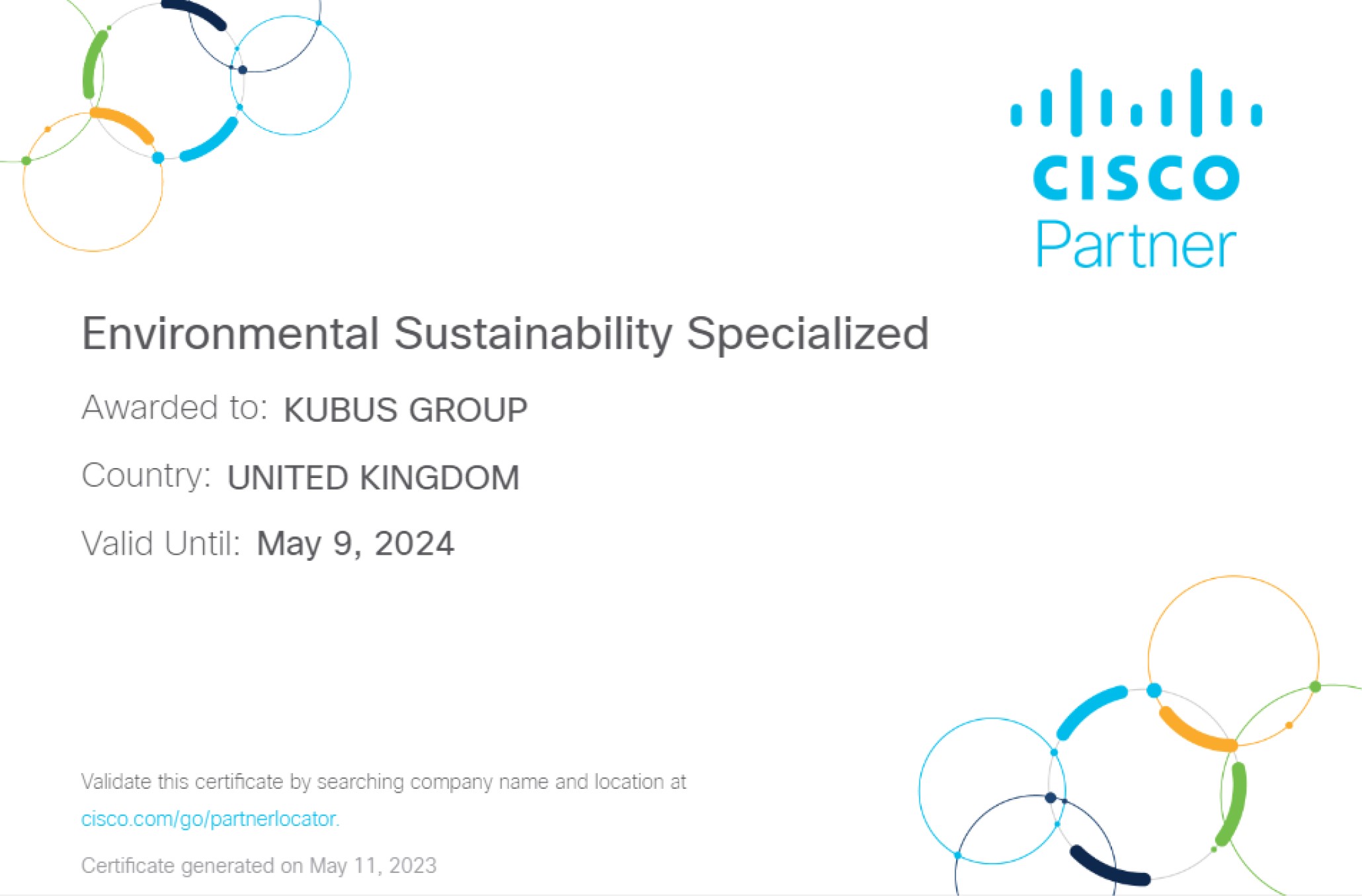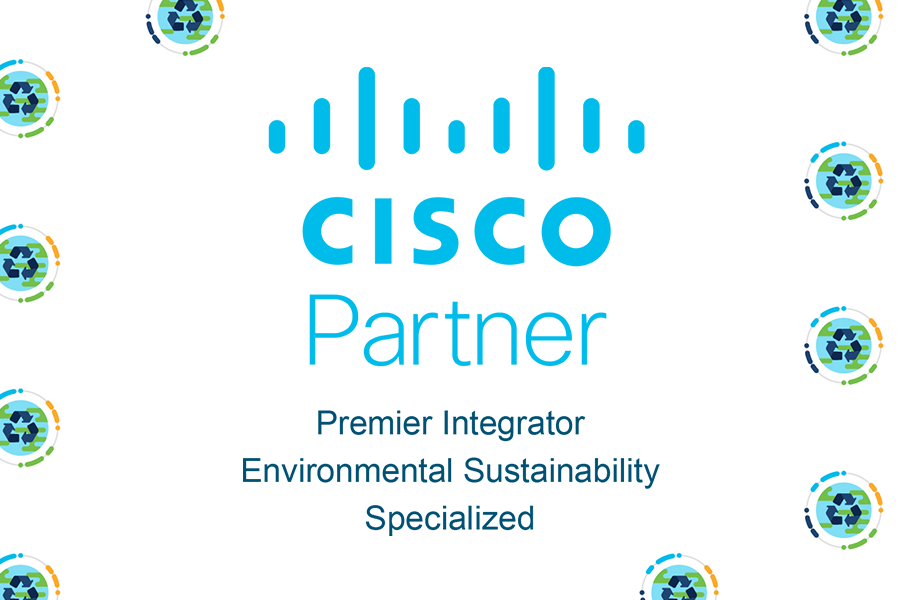Kubus Group Achieves Cisco Partner Enviromental Sustainability Specialization
At Kubus we recognise the importance of making a full and lasting commitment to business and environmental sustainability, and as part of that we pledge to help customers migrate to more sustainable options and responsibly dispose – and where possible recycle – old gear.
Today we are delighted to announce that Kubus has achieved the Environmental Sustainability Specialization (ESS) through the Cisco Partner Program. This distinction indicates our team members have successfully completed exams and courses created to help Cisco Partners operationalize environmental sustainability practices.
The ESS entitles Kubus to participate in Cisco’s Takeback Incentive. The incentive helps Partners who pledge to work together with Cisco towards a sustainable future and commit to returning customers’ used hardware so it can be responsibly reused and recycled.


As part of the Environmental Sustainability Specialization, Kubus has signed Cisco’s Sustainability Pledge that supports a commitment made by Cisco CEO Chuck Robbins to have 100 percent product return on end-of-use hardware. This pledge also supports Cisco’s goals to:
- Be net zero across global Scope 1, 2 and 3 emissions by 2040
- Ensure 100 percent of its products and packaging incorporate Circular Design Principles by FY2025

Duncan Imrie, Chief Financial Officer & Sustainability Lead at Kubus commented, “As a trusted Cisco Partner I am delighted that we can link our own sustainability commitments with Cisco’s. This specialization supports our sustainability leadership and our efforts to differentiate in the marketplace, to open up additional sales opportunities among environmentally conscious customers.”
To find out more about our commitment to lowering our carbon emissions in line with the science-based targets set out by the UNFCCC – to net zero by 2050 – click the following links:
- Kubus sustainability mission
- Kubus environmental management processes
- Kubus carbon reduction plan
- Kubus environmental policy
If you would like to know how Kubus and Cisco working together can benefit your business through environmentally conscious and sustainable procurement, then please do get in touch.
You can independently check our Cisco Credentials on the official Cisco Partner Locator Tool.

Cisco SD-WAN Solutions: How could they help me?
Have a read of a few Cisco SD-WAN case studies from customers across the world to learn more.
A Large Healthcare Organisation
Pierce V. Systems/Network Engineer – Manager
We had started to look at remote connectivity options before the pandemic hit. Last fall, we embarked on a proof of concept using Cisco SD-WAN technology. We decided to limit ourselves to one vendor for SD-WAN because we wanted to stay with a single platform to manage both our on-prem and offsite users.
There are two key benefits to SD-WAN technology:
- It works over any public internet connection. We don’t have to lease special lines or sign SLAs with ISPs to ensure a stable and secure connection. The SD-WAN router shapes traffic and creates a secure tunnel that connects users to our network 24/7.
- The cloud-based configuration and activation. Our remote access support team can set up a Cisco SD-WAN router here and activate it after an employee brings it home. It’s plug and play for end users and administrators, and a lot easier to manage than setting up individual VPN accounts and login credentials.
As a result of the recent pandemic, we fast-tracked our implementation of this solution.
Our call center employees are now working from home because they cannot maintain social distancing at our facilities. As a primary point of contact with the healthcare network, they are frontline workers despite working remotely. We cannot risk compromising their call quality or access to our electronic health records and our booking systems by connecting them to our network via a lossy VPN connection.
We are also providing SD-WAN connectivity to cardiologists, radiologist, and other specialists who need to download high-resolution image files like CT scans, MRIs, and X-rays. These documents are gigabytes in size and require the fastest and most stable connection we can provide to ensure their reliable transmission, and an SD-WAN link is the next best thing to a dedicated line.
I have an SD-WAN connection in my house, and it feels like I’m back at the office. I have access to our shared drives, monitoring systems, and data centers, 24/7. I can walk into my home office, wake up my computer, and I’m on the corporate network in seconds. It’s seamless.
One of my voice team members is on the West Coast and connects to our network from his home in California. There are roughly 80 milliseconds of lag between his router and our data center, but you can’t tell when you’re talking to him. He’s got a couple of phones on his desk but sounds like he’s in the next room, and not 2,500 miles away. We couldn’t have pulled this off with a VPN connection. The call clarity is astounding.
VR Group – Transport
Pasi Louko Senior Network Architect
Cisco’s software-defined network solution provides the perfect combination of security, scalability, and flexibility. It is completely unmatched in the market.
With the vision of the perfect architecture in my mind, and Cisco’s SD-WAN tools in my hands, I presented my plan to management. I designed the entire infrastructure in advance, including a three-phase timeline. My supervisor, saw the simplicity and power in my design, and I received a green light for the plan.
By September 2019, we’d completed the core infrastructure design. Since we are owned by the Finnish government, we needed to hold a public competition to find an operating partner who would manage our network. The entire process took five to six weeks, but by early February 2020 we signed the contract and were ready to begin the actual migration.
We had multiple sessions designing our new network-and the processes that went along with it. Under the new design, VR Group network architects like myself would be entirely responsible for design management. We own the devices and support contracts and provide operators with templates for any infrastructure problems or changes. The operators serve more of a direct physical support role, focused on basic operational matters.
Using this process gives the network architects greater control over a more centralized and unified structure. Changes to the entire network can be made in a matter of hours instead of taking several days. Meanwhile, the operators are happy because using templates-rather than having to perform manual changes-makes their work much easier. This alone provides a significant reduction in costs and employee time.
We also saved money on hardware. With a system that was more than a decade old, we were eventually going to have to update it. That would have required a large upfront capital investment, which wasn’t exactly in line with our cost-reduction goals. Using a software-defined network, however, changed that reality. Our larger offices no longer used cables. Most of our staff and equipment operated using Wi-Fi, with smaller offices using LTE and larger facilities using 4G connections. While these may not seem like a big deal, every little bit matters to that bottom line.
Transitioning to SD-WAN represents a huge leap forward for our company, and indeed our country. Traditional infrastructure uses static routing, which requires large investments of money and time to make changes. Our new software-based architecture, however, has transformed VR Group into a company that is truly dynamic. Any required changes or updates happen faster and easier and only have to be made once before being automatically updated to every device. Our structure is unified, with a central unit providing design oversight.
As a testament to the speed of provision, in two months, we have migrated more than 96% of our users to the new network. I love the standardization and simplified network management. My supervisors love that operational costs are significantly reduced because of new SD-WAN solution. We expect to complete phase one within the coming weeks, with all users on the new network. Phase two of the process will focus on implementing stronger security measures and a simplified firewall structure. After we have lived with the system for a while, phase three will involve a closer system review and an examination of unnecessary hardware.
With this new system in place, Cisco will have helped VR Group drastically improve our efficiency. By the time we finish phase three, we will have a complete and ongoing picture of the traffic flow between services and clients. We will be better able to manage the scope and flow of our applications and better select security products according to our needs.Anyone who has been in IT for a while understands how quickly equipment, infrastructure, and applications can become outdated. Most of us have inherited solutions that probably worked great when first purchased, but whose effectiveness has lessened over time. Thanks to the incredible flexibility inherent to the software-defined model, Cisco has helped us overhaul our network and continue our operational efficiencies for years to come. When it comes to the future of transportation in Finland, VR Group is definitely on the right track.
Tamimi Markets – Retail
Joel Marquez IT Director
I started here as a programmer in 1993 and am now the Director of IT. The supermarket industry has shifted from on-prem applications to cloud-based solutions, and we had to change with the times.
Our WAN was another challenge. Network traffic from our supermarkets, warehouses, branch offices, and remote users were all routed through our head office via three separate ISPs. The only way we could protect our data was via IPSEC over MPLS (IPVPN) tunnels which slowed connectivity and blocked visibility. We couldn’t tell, for example, if a marketing manager working from home had proper endpoint protection on their computer.
We were also 100% dependent on these three ISPs—who typically didn’t talk to one another—for end-to-end connectivity. If one of them slowed down due to network congestion or went offline due to a system failure, we were at their mercy. Stores and offices that used their infrastructure were cut off from our head office and the rest of our network.
We also suffered from a lack of control over the quality of network services or infrastructure upgrades. When we needed new capacity, we added physical equipment at each of our locations. It was costly and the installation and configuration was all manual. After the extra effort and expense, we still had to contend with limited bandwidth from our ISP partners. Essentially, we were employing band-aid solutions as the demands on our network grew. Our overall IT infrastructure had become obsolete and stretched too thin.
The impact of these deficiencies was huge. Our network was slow, poorly secured, and not very visible. In broad terms, our growth and brand image suffered as customers became frustrated with long checkout lines caused by network delays and waiting for their loyalty points to be recognized. Our out-of-date software and slow network connections were impacting our business and reputation.
We needed to upgrade our IT infrastructure and reflect our new and innovative image by improving both service and the total shopping experience. We also needed an IT infrastructure that could keep up with our aggressive growth plans.
Putting out calls for vendors and went through several proofs of concept. At the end of our selection process, one solution stood out: Cisco Secure Access Service Edge (SASE) including Cisco SD-WAN and Cisco Umbrella.
The outcome…
Cisco SD-WAN allowed us to switch from a traditional network to a software-defined infrastructure. The first and foremost of its benefits is true branch independence through direct internet access. Our stores, warehouses, and offices no longer have to backhaul network traffic through our headquarters to talk to one another, which speeds things up tremendously.
The second advantage is carrier independence. The beauty of an SD-WAN solution is that it frees you to choose whatever public or private infrastructure is most convenient. We are no longer constrained to our three ISPs. We have retooled our setup, and our branches are now connected via a fiber loop. We run broadband on copper (Business DSL) as a backup, 4G for wireless, and eventually 5G. If one of these networks fails, it switches automatically to another. We no longer have to wait for a provider to effect repairs and are assured of connectivity between locations by rerouting it across other infrastructure.
We can also add or change service providers with ease when better options present themselves or if we need more bandwidth. In the past, we had to accept outrageous rate hikes whenever we needed more bandwidth or speed. Now, we are free to shop around and get what we need without adding physical equipment to our network.
Using the Cisco SD-WAN integration with Cisco Umbrella gives us effective cloud security throughout our SD-WAN fabric. We can now see which devices employees are using to connect to Tamimi Markets’ SD-WAN, restrict them to the most secure protocols, and even limit the applications they can use while connected to the network. We’ve never had application visibility like this before. This added security protects our staff from the ever-present threats on the internet.
The secure SD-WAN integration offers the flexibility and security we need to update our IT infrastructure and better serve our customers and employees. I’m a long-time fan of Cisco, and I knew they could deliver the product we needed, but the real difference is their support. With other suppliers, my engineers could spend hours on Google looking for ways to resolve an issue. With Cisco, we open a ticket, and they get back to us in no time. You don’t get that level of service from other technology partners.
Although COVID-19 slowed the planned deployment of our new infrastructure, I’ve already noticed a tremendous improvement in speed, stability, and bandwidth across all our operations utilizing SD-WAN. Like most companies, we’ve had to use video conferencing for many of our meetings during the pandemic. In the past, this meant putting up with severe lags that caused garbled sound and stuttering video. It was impossible to communicate clearly or get anything done.
With Cisco SD-WAN, those days are behind us. Our new infrastructure handles video traffic with ease. It has also improved the customer experience for Tamimi Markets shoppers. Our points of sale have a seamless and fast connection to our customer loyalty database and other cloud-based utilities, thus accelerating the checkout process. Our growing customer base no longer has to wait for access to their loyalty points and paying for their purchases is much faster.
With Cisco SD-WAN and Cisco Umbrella, combining to form a true SASE solution, we have achieved direct-to-internet access which helps us propel inventory management and other processes that put food on our shelves, satisfies our customers, and keeps them coming back to Tamimi Markets with smiles and anticipation of an even more enjoyable shopping experience. Now that’s a competitive advantage!


